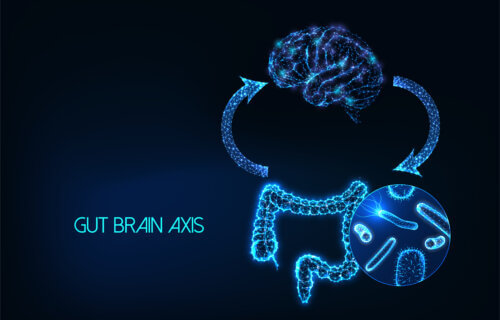What if the microbes in your gut could act as an early warning system, alerting you that you could be developing Alzheimer’s disease? This might sound improbable, but recent research has found certain microbes are more common in those with very early signs of the disease, pointing to a potential new method of diagnosis for a disease that affects millions worldwide.
The gut microbiome is the collection of microbes, which include bacteria, viruses and fungi, in the gut. Having diverse populations of microbes is thought to be important for our overall health. However, in certain circumstances, the gut microbiome can also contain microbes that are harmful to our health.
In Alzheimer’s, two proteins, known as amyloid-beta and tau, accumulate abnormally in the brain. Their presence results in the characteristic memory loss and cognitive decline associated with the disease, with symptoms becoming progressively worse with time.
It’s known that amyloid-beta and tau begin to accumulate long before the onset of Alzheimer’s symptoms. It’s at this stage (known as the “preclinical stage”) that the researchers saw changes in the gut microbiome.
The researchers found distinct differences in the gut microbiome profiles of older people with and without signs of preclinical Alzheimer’s. In those with signs of preclinical Alzheimer’s, the differences in the gut microbiome appeared to be connected to the accumulation of amyloid-beta and tau proteins in the brain.
Doctors currently rely on the results of various diagnostic tests to assess whether someone may have preclinical Alzheimer’s. The researchers combined these results with their participant’s gut microbiome data and put it into a machine learning algorithm, a computer program that can make predictions based on the data that you give it.

They found that including the gut microbiome data improved the algorithm’s ability to diagnose preclinical Alzheimer’s accurately. This remained the case even when not all the diagnostic test data was included.
Some of the diagnostic tests for preclinical Alzheimer’s may be unpleasant, such as a lumbar puncture, or rely on expensive imaging technologies, such as magnetic resonance imaging (MRI) scanners, access to which is known to be unequal globally.
The idea of analyzing a person’s gut microbiome, which only requires a stool (poo) sample, to assess their risk of developing the disease is appealing. It would offer a non-invasive, more accessible way of identifying those at risk of developing Alzheimer’s at an earlier stage, allowing them more time to plan and prepare for the future.
It should be noted, however, that the improvement found by the study in predicting preclinical Alzheimer’s by including the gut microbiome data was quite modest. So, while analyzing gut microbiome data might complement existing methods for diagnosing preclinical Alzheimer’s, it can’t replace them just yet.
Curious finding
Unexpectedly, some of the species found to be associated with signs of preclinical Alzheimer’s have previously been thought to be beneficial for human health. One of those identified is a bacteria known as Faecalibacterium prausnitzii (F. prausnitzii), which, in a previous study, was found to be more common in the gut microbiome of people without Alzheimer’s compared to those with the disease.
It’s unclear why what are considered to be potentially beneficial microbes were associated with those with symptoms of preclinical Alzheimer’s, as opposed to those who were cognitively healthy.
One explanation might be the stage of the disease. It’s important to recognize that not everyone who has signs of preclinical Alzheimer’s will go on to develop Alzheimer’s itself. There may be changes to the gut microbiome that happen in later stages of the disease, such as the loss of F. prausnitzii.
While it might be tempting to conclude that the gut microbes identified as being associated with signs of preclinical Alzheimer’s are also contributing to developing the disease, the study does not provide any evidence of a cause-and-effect relationship.
However, if a connection can be established, it opens up an exciting possibility that future treatments for Alzheimer’s might target the microbes in our gut.![]()
Article written by Catherine Purse, PhD Candidate in Microbiology, Quadram Institute
This article is republished from The Conversation under a Creative Commons license. Read the original article.
You might also be interested in:
- Yogurt every day keeps Alzheimer’s away? Probiotics, strong gut health may be key to avoiding dementia
- Obesity breakthrough? Brain signals reveal why men and women gain weight differently
- A spoonful of olive oil daily could save your brain from dementia

